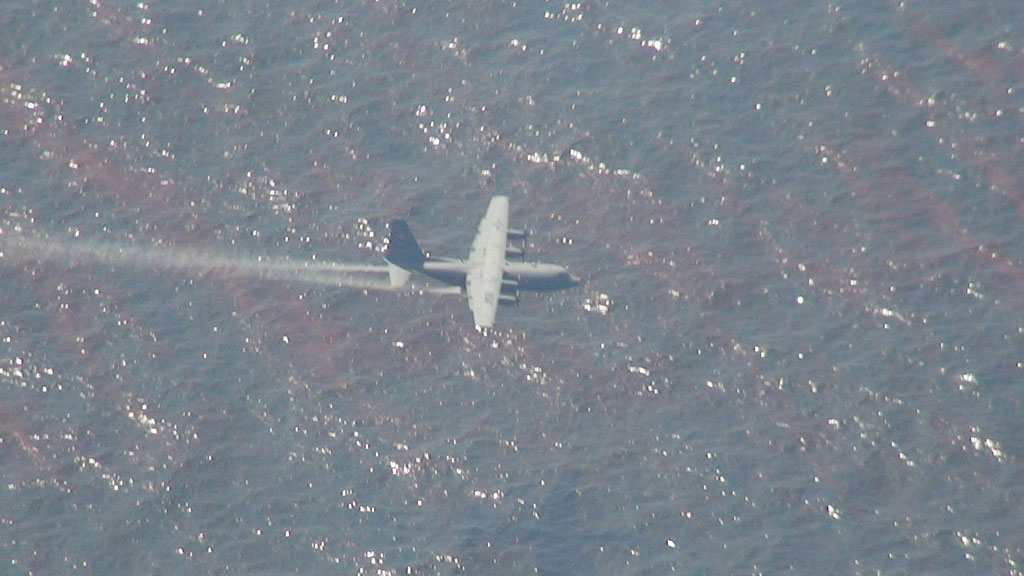
Plane Drops Dispersants on Oil Spill. Captions and Photo source: ©© NWF
Excerpts;
Experts argue for further in-depth assessments of the impacts of dispersants on microorganisms to guide their use in response to future oil spills. Chemical dispersants are widely used in emergency responses to oil spills in marine environments as a means of stimulating microbial degradation of oil. After the Deepwater Horizon spill in 2010, dispersants were applied to the sea surface and deep waters of the Gulf of Mexico, the latter of which was unprecedented. Dispersants were used as a first line of defense even though little is known about how they affect microbial communities or the biodegradation activities they are intended to spur…
Read Full Article, Science Daily
Oil Dispersant Used in Gulf Oil Spill Causes Lung and Gill Injuries to Humans and Aquatic Animals, University of Alabama at Birmingham (04-06-2015)
New research suggests that Corexit EC9500A, an oil-dispersal agent widely used in the Gulf of Mexico following the Deepwater Horizon oil spill, contributes to damage to epithelium cells within the lungs of humans and gills of marine creatures…
Scientists find damage to coral near BP well, (11-06-2010)
For the first time, federal scientists have found damage to deep sea coral and other marine life on the ocean floor several miles from the blown-out BP well, a strong indication that damage from the spill could be significantly greater than officials had previously acknowledged…
Oil Spill Dispersants Shifting Ecosystem Impacts in Gulf, Scientists Warn, The New York Times (07-30-2010)
A seemingly feel-good story showed up this week on the nation’s front pages and newscasts: The oil that befouled the Gulf of Mexico for 86 days is vanishing from the surface, leaving workers with little to clean. But scientists warn the oil’s ecological impacts are shifting, not ebbing, thanks to massive volumes of dispersants that have kept the crude beneath the waves…
First Study of Dispersants in Gulf Spill Suggests a Prolonged Deepwater Fate (01-27-2011)
To combat Deepwater Horizon oil spill, nearly 800,000 gallons of chemical dispersant were injected directly into the oil and gas flow coming out of the wellhead. Scientists begin to assess and to raise questions about what impact the deep-water residue of oil and dispersant, might have had on environment and marine life in the Gulf…
Gulf Oil Spill: Oil-Dispersing Chemicals Had Little Effect On Oil Surfacing, Science Daily (12-04-2012)
As the Deepwater Horizon incident unfolded, in an effort to prevent the oil from coming to the surface and reaching coastal and marsh ecosystems, chemical dispersants were injected at the wellhead. A new study is the first to examine the effects of the use of unprecedented quantities of dispersants, over such a prolonged period of time in the deep ocean…
Scientists and Academics Call For Immediate Halt of Chemical Dispersants in Gulf, The Ocean Foundation (07-26-2010)
Over 100 scientists and academic institution, research laboratory, conservation organization leaders plus human rights defenders from as far away as Norway and Greece have issued, July 18th, a joint Scientists Consensus Statement on the Use of Chemical Dispersants in the Gulf of Mexico calling for the US Administration to immediately halt chemical aerial spraying in the Gulf region. BP has used nearly two million gallons of Corexit chemical dispersants in the Gulf of Mexico as part of the cleanup effort with support from the U.S. Environmental Protection Agency (EPA). The massive volume of dispersants and the way they have been applied, both on the surface and one mile below the surface, is unprecedented. Once oil is dispersed in deep water, it cannot be recovered. The scientists believe the worst impacts of the disaster are yet to come, and without deliberate, independent scientific tracking and assessment, they could remain hidden…









